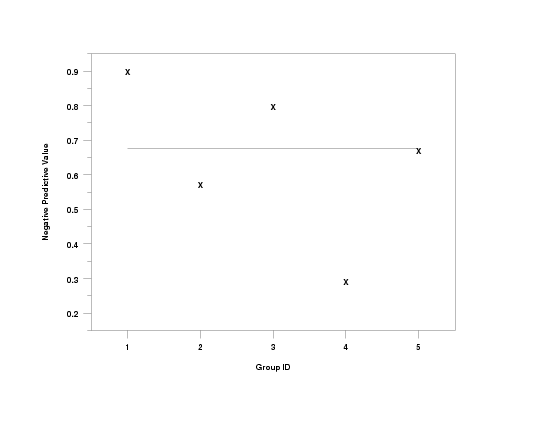

|
NEGATIVE PREDICTIVE VALUEName:
The parameters N11, N12, N21, and N22 denote the counts for each category. Success and failure can denote any binary response. Dataplot expects "success" to be coded as "1" and "failure" to be coded as "0". Some typical examples would be:
In these examples, the "ground truth" is typically given as variable 1 while some estimator of the ground truth is given as variable 2. The negative predictive value is then N12/(N12+N22). This is the conditional probability of variable 1 being false given that variable 2 is false. In the context of the first example above, this is the probability that the disease is not present when there is a negative test result. Fleiss and his co-authors recommend negative predictive value and positive predictive value as an alternative to false positive and false negative due to the fact that the definitions of false positive and false negative have been inconsistent in the literature.
<SUBSET/EXCEPT/FOR qualification> where <y1> is the first response variable; <y2> is the second response variable; <par> is a parameter where the computed negative predictive value is stored; and where the <SUBSET/EXCEPT/FOR qualification> is optional.
LET A = NEGATIVE PREDICTIVE VALUE Y1 Y2 SUBSET TAG > 2
CROSS TABULATE FALSE POSITIVE Y1 Y2 X1 X2 FALSE POSITIVES PLOT Y1 Y2 X CROSS TABULATE FALSE POSITIVES PLOT Y1 Y2 X1 X2 BOOTSTRAP FALSE POSITIVES PLOT Y1 Y2 JACKNIFE FALSE POSITIVES PLOT Y1 Y2
let n = 1
.
let p = 0.2
let y1 = binomial rand numb for i = 1 1 100
let p = 0.1
let y2 = binomial rand numb for i = 1 1 100
.
let p = 0.4
let y1 = binomial rand numb for i = 101 1 200
let p = 0.08
let y2 = binomial rand numb for i = 101 1 200
.
let p = 0.15
let y1 = binomial rand numb for i = 201 1 300
let p = 0.18
let y2 = binomial rand numb for i = 201 1 300
.
let p = 0.6
let y1 = binomial rand numb for i = 301 1 400
let p = 0.45
let y2 = binomial rand numb for i = 301 1 400
.
let p = 0.3
let y1 = binomial rand numb for i = 401 1 500
let p = 0.1
let y2 = binomial rand numb for i = 401 1 500
.
let x = sequence 1 100 1 5
.
let a = negative predictive value y1 y2 subset x = 1
tabulate negative predictive value y1 y2 x
.
label case asis
xlimits 1 5
major xtic mark number 5
minor xtic mark number 0
xtic mark offset 0.5 0.5
ytic mark offset 0.05 0.05
y1label Negative Predictive Value
x1label Group ID
character x blank
line blank solid
.
negative predictive value plot y1 y2 x

| |||||||||||||||||||||||||||||||||||||||||||||||||||||||||||||
|
Privacy
Policy/Security Notice
NIST is an agency of the U.S. Commerce Department.
Date created: 06/06/2007 |
|||||||||||||||||||||||||||||||||||||||||||||||||||||||||||||